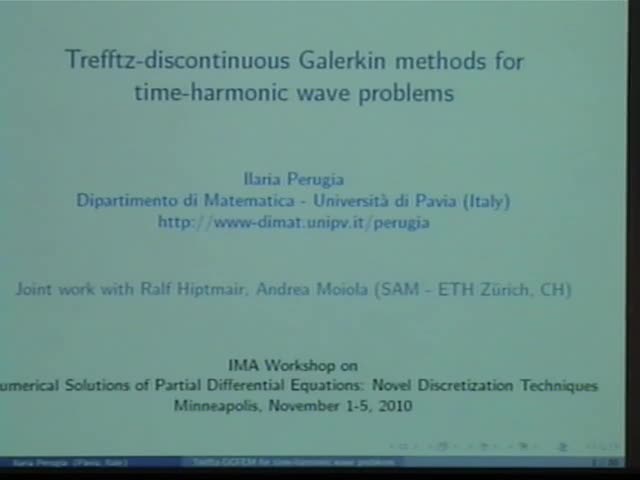Trefftz-discontinuous Galerkin methods for time-harmonic wave problems
Presenter
November 2, 2010
Keywords:
- Wave problems
MSC:
- 35L05
Abstract
Several finite element methods used in the numerical discretization of wave problems in frequency domain are based on incorporating a priori knowledge about the differential equation into the local approximation spaces by using Trefftz-type basis functions, namely functions which belong to the kernel of the considered differential operator. For the Helmholtz equation, for instance, examples of Trefftz basis functions are plane waves, Fourier-Bessel functions and Hankel functions, and there are in the literature several methods based on them: the Plane Wave/Bessel Partition of Unit Method by Babuška and Melenk, the Ultra Weak Variational Formulation by Cessenat and Després, the Plane Wave/Bessel Least Square Method by Monk and Wang, the Discontinuous Enrichment Method by Farhat and co-workers, the Method of Fundamental Solutions by Stojek, to give some examples. These methods differ form one another not only for the type of Trefftz basis functions used in the approximating spaces, but also for the way of imposing continuity at the interelement boundaries: partition of unit, least squares, Lagrange multipliers or discontinuous Galerkin techniques. In this talk, the construction of Trefftz-discontinuous Galerkin methods for both the Helmholtz and the time-harmonic Maxwell problems will be reviewed and their abstract error analysis will be presented. It will also be shown how to derive best approximation error estimates for Trefftz functions, needed to complete the convergence analysis, by using Vekua's theory. Some explicit estimates in the case of plane waves will be given. These results have been obtained in collaboration with Ralf Hiptmair and Andrea Moiola form ETH Zürich.
